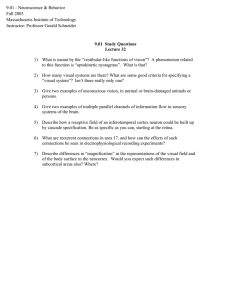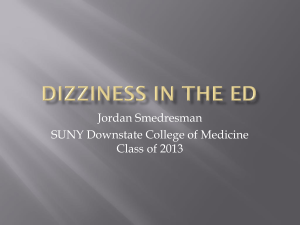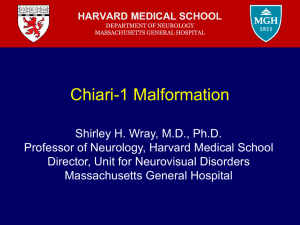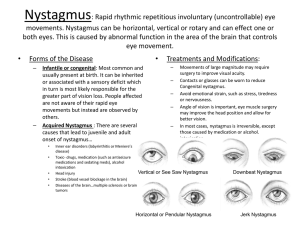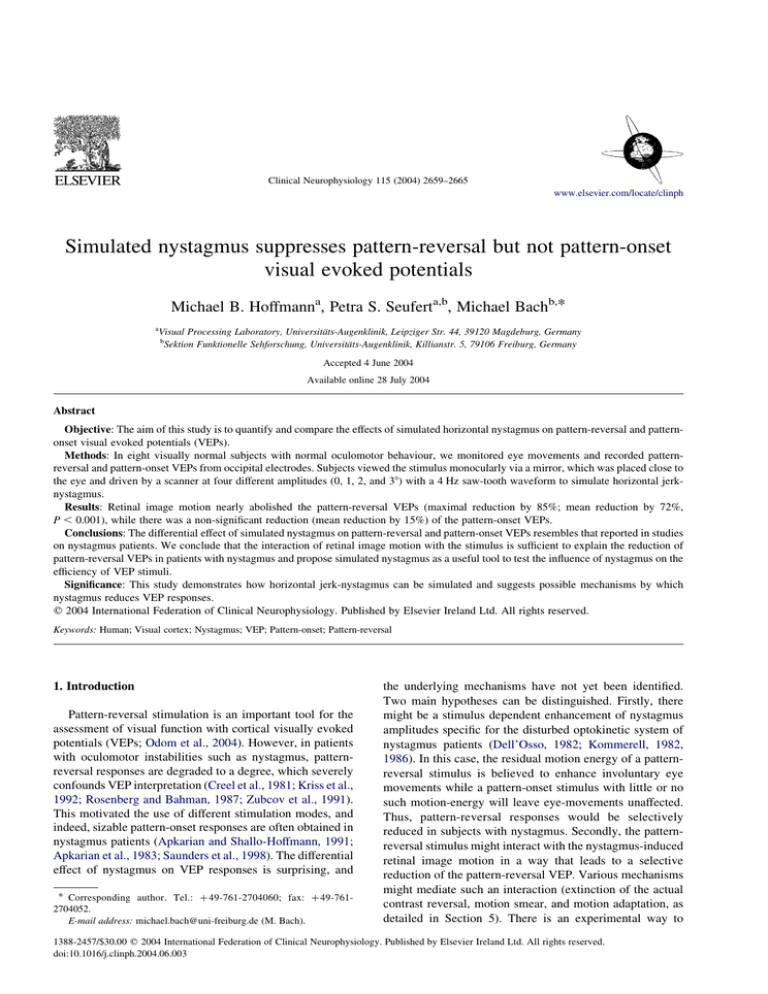
Clinical Neurophysiology 115 (2004) 2659–2665
www.elsevier.com/locate/clinph
Simulated nystagmus suppresses pattern-reversal but not pattern-onset
visual evoked potentials
Michael B. Hoffmanna, Petra S. Seuferta,b, Michael Bachb,*
a
Visual Processing Laboratory, Universitäts-Augenklinik, Leipziger Str. 44, 39120 Magdeburg, Germany
b
Sektion Funktionelle Sehforschung, Universitäts-Augenklinik, Killianstr. 5, 79106 Freiburg, Germany
Accepted 4 June 2004
Available online 28 July 2004
Abstract
Objective: The aim of this study is to quantify and compare the effects of simulated horizontal nystagmus on pattern-reversal and patternonset visual evoked potentials (VEPs).
Methods: In eight visually normal subjects with normal oculomotor behaviour, we monitored eye movements and recorded patternreversal and pattern-onset VEPs from occipital electrodes. Subjects viewed the stimulus monocularly via a mirror, which was placed close to
the eye and driven by a scanner at four different amplitudes (0, 1, 2, and 38) with a 4 Hz saw-tooth waveform to simulate horizontal jerknystagmus.
Results: Retinal image motion nearly abolished the pattern-reversal VEPs (maximal reduction by 85%; mean reduction by 72%,
P , 0:001), while there was a non-significant reduction (mean reduction by 15%) of the pattern-onset VEPs.
Conclusions: The differential effect of simulated nystagmus on pattern-reversal and pattern-onset VEPs resembles that reported in studies
on nystagmus patients. We conclude that the interaction of retinal image motion with the stimulus is sufficient to explain the reduction of
pattern-reversal VEPs in patients with nystagmus and propose simulated nystagmus as a useful tool to test the influence of nystagmus on the
efficiency of VEP stimuli.
Significance: This study demonstrates how horizontal jerk-nystagmus can be simulated and suggests possible mechanisms by which
nystagmus reduces VEP responses.
q 2004 International Federation of Clinical Neurophysiology. Published by Elsevier Ireland Ltd. All rights reserved.
Keywords: Human; Visual cortex; Nystagmus; VEP; Pattern-onset; Pattern-reversal
1. Introduction
Pattern-reversal stimulation is an important tool for the
assessment of visual function with cortical visually evoked
potentials (VEPs; Odom et al., 2004). However, in patients
with oculomotor instabilities such as nystagmus, patternreversal responses are degraded to a degree, which severely
confounds VEP interpretation (Creel et al., 1981; Kriss et al.,
1992; Rosenberg and Bahman, 1987; Zubcov et al., 1991).
This motivated the use of different stimulation modes, and
indeed, sizable pattern-onset responses are often obtained in
nystagmus patients (Apkarian and Shallo-Hoffmann, 1991;
Apkarian et al., 1983; Saunders et al., 1998). The differential
effect of nystagmus on VEP responses is surprising, and
* Corresponding author. Tel.: þ 49-761-2704060; fax: þ 49-7612704052.
E-mail address: michael.bach@uni-freiburg.de (M. Bach).
the underlying mechanisms have not yet been identified.
Two main hypotheses can be distinguished. Firstly, there
might be a stimulus dependent enhancement of nystagmus
amplitudes specific for the disturbed optokinetic system of
nystagmus patients (Dell’Osso, 1982; Kommerell, 1982,
1986). In this case, the residual motion energy of a patternreversal stimulus is believed to enhance involuntary eye
movements while a pattern-onset stimulus with little or no
such motion-energy will leave eye-movements unaffected.
Thus, pattern-reversal responses would be selectively
reduced in subjects with nystagmus. Secondly, the patternreversal stimulus might interact with the nystagmus-induced
retinal image motion in a way that leads to a selective
reduction of the pattern-reversal VEP. Various mechanisms
might mediate such an interaction (extinction of the actual
contrast reversal, motion smear, and motion adaptation, as
detailed in Section 5). There is an experimental way to
1388-2457/$30.00 q 2004 International Federation of Clinical Neurophysiology. Published by Elsevier Ireland Ltd. All rights reserved.
doi:10.1016/j.clinph.2004.06.003
2660
M.B. Hoffmann et al. / Clinical Neurophysiology 115 (2004) 2659–2665
differentiate between these two hypotheses: the superimposition of retinal image motion onto the VEP stimulus in
normal subjects, i.e. without nystagmus, should exert a
differential effect on pattern-reversal and pattern-onset
responses, if the ‘oculomotor-hypothesis’, outlined above,
is invalid.
In the present study, we simulated horizontal jerknystagmus in normal subjects by superimposing nystagmuslike retinal image motion onto the pattern-reversal and
pattern-onset stimuli during VEP recordings. Such an
approach has the benefit to directly compare conditions
with different degrees of simulated nystagmus amplitudes to
a reference condition without any nystagmus in the same
subject. Thus, we tested whether nystagmus-like retinal
image motion affects VEP responses in subjects without real
nystagmus in the same differential manner as has previously
been demonstrated in nystagmus patients. This would not
only demonstrate that the interaction between retinal image
motion and the stimulus time course are sufficient to explain
the selective reduction of pattern-reversal VEPs, it would
also indicate that induced retinal image motion is a valid
model that allows us to screen a variety of VEP stimuli for
their use in nystagmus patients.
2. Methods
2.1. Subjects
Eight subjects aged 18– 35 years with normal visual
acuity gave their informed written consent prior to the study.
The procedures followed the tenets of the declaration of
Helsinki (World Medical Association, 2000) and the
protocol was approved by the ethics committee of the
University of Freiburg, Germany.
During the experiments, subjects viewed the stimulus
with their left eye via a first-surface mirror (as detailed in
Sections 2.2 and 2.2.3), while their right eye was patched.
They were instructed to rest their gaze in the centre of the
stimulus pattern and to focus on the pattern.
2.2. Stimulation
Stimuli were generated by a Power Macintosh G4
with a program based on the Apple Game sprockets
(Bach, 1999) and presented on a CRT with a frame rate
of 75 Hz.
2.2.1. Spatial stimulus characteristics
In accordance with the VEP standard (Odom et al.,
2004), black-and-white checkerboard patterns with either of
two check sizes, 0.25 and 18 of visual angle were tested. The
pattern had a mean luminance of 27 cd/m2, 98% contrast,
and a horizontal and vertical extent of 26 and 218,
respectively. Subjects viewed the stimulus via a first-surface
mirror that was placed at a distance of 10 cm from their eye
and at a distance of 25 cm from the CRT, resulting in a total
viewing distance of 35 cm.
2.2.2. Temporal stimulus characteristics
Two stimulation modes were tested: pattern-reversal (one
reversal per 493 ms) and pattern-onset stimulation (ON for
40 ms; OFF for 440 ms). For pattern-onset, an onset epoch of
40 ms was chosen as this corresponds to the integration time
for checkerboard onset and gives the largest responses
(Jeffreys and Axford, 1972; Spekreijse et al., 1973) and as the
same value has previously been used in VEP studies on
nystagmus-patients (Apkarian and Shallo-Hoffmann, 1991).
In the VEP literature, it is a common practice to refer to both
pattern-onset and brief pattern-onset stimulation as patternonset, although the latter should in fact be referred to as
‘pattern-pulse’. Throughout this article, we will adhere to the
established terminology and refer to brief pattern-onset, i.e.
pattern-pulse, simply as pattern-onset.
2.2.3. Simulation of nystagmus
We simulated horizontal jerk-nystagmus by oscillating a
first-surface mirror in front of the subjects’ eye around the
vertical axis. Such an approach has been used in previous
psychophysical studies, which demonstrated a similar effect
of simulated and genuine nystagmus on visual acuity
(Chung and Bedell, 1997; Ukwade and Bedell, 1999).
Mirror motion was induced by a scanner (Scanner Control
CCX 01; General Scanning Inc.), which controlled the
mirror. The input signal for the scanner-mirror was
generated with IGOR (Wavemetrics, Inc.) by a Power
Macintosh G4 and converted to an analogue signal via the
audio output. The use of the audio output was possible due
to the low time constant of the audio-out high-pass filter.
The mirror moved with a saw-tooth time-course of an
amplitude of either 0, 1, 2, or 38 of visual angle as calibrated
psychophysically within an error of 10%. During VEP
recordings, the mirror moved at a frequency of 4 Hz as this
is typical for idiopathic congenital nystagmus (Abadi and
Worfolk, 1989; Bedell and Loshin, 1991; Yee et al., 1976).
It should be noted that the frequency was incommensurable
with the stimulation rate, i.e. not a multiple. Over the entire
time course of the VEP recordings, there is, consequently,
no time-locked relationship of stimulus onset and any
particular phase of the mirror movement. This is important
as it excludes the possibility that responses to any particular
phase of mirror motion are extracted from the electroencephalogram during the averaging process, which eventually yields the VEP.
3. Electrophysiological recordings
3.1. VEP recordings
Electrodes were placed and labelled according to the
international 10– 20 System (American Encephalographic
M.B. Hoffmann et al. / Clinical Neurophysiology 115 (2004) 2659–2665
Society, 1994). Potentials were recorded from three scalp
electrodes referenced to Fz: Oz (occipital pole), PO7, and
PO8. The ground electrode was attached to the right wrist.
VEPs were averaged over at least 176 trials for each
stimulus condition. Signals were amplified, filtered (firstorder bandpass, 0.3– 70 Hz, Toennies ‘Physiologic Amplifier’), and digitized to a resolution of 12 bits at a sampling
frequency of 1 kHz with a Macintosh 7200 computer. Using
LabView (National Instruments), signals were ‘streamed to
disk’ and also averaged on-line to monitor the recording.
3.2. EOG-recordings
We recorded the horizontal electro-oculogram (EOG)
bitemporally to monitor eye movements and the vertical
EOG of the left eye for blink detection. EOGs were
amplified, and digitized at a sampling rate of 1000 Hz. The
horizontal EOG was calibrated just before the beginning of
the VEP recordings.
3.3. Data-analysis
3.3.1. VEP analysis
Trials were analysed off-line with Igor Pro (Wavemetrics, Inc.) for an interval that began 100 ms prior to
stimulus onset and ended 400 ms after stimulus onset. Trials
with blinks, detected with a threshold criterion of 100 mV,
were discarded. Sweeps were pooled according to stimulus
conditions and digitally filtered (0 – 40 Hz) before averaging. The zero level was defined as the mean value of the
averaged trace from 100 ms before to 70 ms after stimulus
onset and used as reference for peak measurements.
3.3.2. EOG analysis
For the quantification of the impact of simulated
nystagmus on eye-movements, the EOG recordings were
Fourier-analysed which allowed the assessment of the EOG
amplitude at the fundamental frequency of the mirrormovement and at the fundamental frequency of the
stimulus. The content of the fundamental frequency of the
mirror-movement in the EOG recording was analysed over a
10 s window, resulting in a frequency resolution of 0.1 Hz,
the content of the fundamental frequency of the stimulus in
the EOG was analysed over a 37 s window, resulting in a
frequency resolution of 0.03 Hz. In all cases, the analysis
epochs comprised an exact integer number of mirror- and
stimulus-periods, respectively, to avoid overspill onto
neighbouring frequencies (Bach and Meigen, 1999); this
also obviates the use of a window function.
3.4. Procedure
An entire recording session lasted around 2 h, including
preparation and breaks. Overall, 16 stimulus conditions
were tested, i.e. two stimulation modes (pattern-onset/pattern-reversal), four mirror-amplitudes (0, 1, 2, and, 38),
2661
and two check sizes (1 and 0.258). The session was split into
two halves. During the first part stimulus check size was 18,
during the second half 0.258. Stimuli were presented in short
blocks of 120 trials, lasting about 80 s. For each stimulus
condition a total of 240 trials were presented, leaving at least
176 artefact-free trials as determined with a threshold
criterion (see above, VEP-Analysis). VEP recordings
started with a presentation of a pattern-reversal and
pattern-onset block at a mirror-amplitude of 08. Then
these blocks were repeated with the next-higher mirror
amplitude. Once an amplitude of 38 was reached, there was
a break for the subject to recover from any adaptation and
fatigue effects. Finally, the entire sequence was repeated
with an inverted sequence of pattern-reversal and patternonset blocks. This design was chosen to avoid overspill of
any adaptation effects from mirror motion into blocks with
smaller or no mirror motion.
3.5. Analysis and statistics
To test the significance of the effect of simulated
nystagmus on response amplitude, a peak analysis of the
individual traces of each subject was performed. Univariate
ANOVAs were applied to the logarithmised amplitude
differences of P1 – N2 for pattern-reversal and CIII –CII for
pattern-onset responses. The Student-Newman-Keuls test
was used for post-hoc testing of significances.
4. Results
4.1. Effect of simulated nystagmus on pattern-reversal
and pattern-onset VEPs
For a qualitative assessment of the effects, the grand
mean traces are depicted for each recording site, both
stimulation modes, and all four amplitudes of retinal image
motion in Fig. 1. Fig. 1(a) and (b) show the results for 1 and
0.258 checks, respectively. The various VEP components—
N1, P1, and N2 for pattern-reversal and CI, CII, and CIII for
pattern-onset-are indicated in Fig. 1. Fig. 1 shows that
pattern-reversal responses are strongly reduced by retinal
image motion even of small extent, i.e. 18, while patternonset responses are little or not affected. These effects can
be observed at all of the three recording sites and are also
evident in the original VEP traces of the individual subjects.
A quantitative account of these features is given in Fig. 2(a)
and (b), for 1 and 0.258 check size, respectively, and in
Table 1. The individual peak differences, P1 – N2 for
pattern-reversal and CIII – CII for pattern-onset, were
determined in the individual VEP traces of each single
subject, subsequently, averaged across subjects, and plotted
as a function of simulated nystagmus amplitude. The same
trends as for the grand mean traces depicted in Fig. 1 are
evident: pattern-reversal responses are significantly affected
by simulated nystagmus (mean reduction across both check
2662
M.B. Hoffmann et al. / Clinical Neurophysiology 115 (2004) 2659–2665
Fig. 1. Grand mean VEP traces (eight subjects) at three derivations for different degrees of simulated nystagmus. The typical main components of the patternreversal VEP (N1, P1, N2) and of the pattern-onset VEP (CI, CII, CIII) are indicated. Pattern-reversal responses are severely affected by small amplitudes, i.e.
18, of simulated nystagmus, while there is only little effect on pattern-onset responses even at high amplitudes of simulated nystagmus, i.e. 38. This holds for
both check sizes (see (a) and (b)).
sizes and all three mirror amplitudes by 72%; P , 0:001;
Table 1), while the effect on pattern-onset responses does
not reach significance (mean reduction across check sizes
and mirror amplitudes by 15%; P . 0:22). Note that there is
not even a slight indication of an effect of 18 simulated
nystagmus on pattern-onset responses, while patternreversal responses are already significantly affected at this
level of simulated nystagmus (Fig. 2) as revealed by post
hoc testing of pattern-reversal responses: for 18 check size
all possible pair-wise differences between mirror amplitude
M.B. Hoffmann et al. / Clinical Neurophysiology 115 (2004) 2659–2665
2663
Fig. 2. Dependence of the VEP responses recorded at Oz on the amplitude of simulated nystagmus (n ¼ 8; mean ^ SEM). The amplitude differences of the
most prominent peaks [N1 and P1 for pattern-reversal (PR) and CII and CIII for pattern-onset stimulation (PO)] are depicted. It is evident that pattern-reversal
responses are severely affected by simulated nystagmus while pattern-onset responses are not or only little affected.
conditions were significant at a 5% level, for 0.258 check
size all differences to the 08 mirror-amplitude conditions
were significant at this level.
4.2. Effect of simulated nystagmus on eye-movements during
visual stimulation
Simultaneous recordings of VEP and EOG enabled us to
assess whether simulated nystagmus induces eye movements. Inspection of the EOG traces revealed that the
mirror-excursions disturbed the fixation stability. They
induced jerk-nystagmus-like eye movements during pattern-onset stimulation and square-wave jerks during patternreversal stimulation. These induced fixation instabilities had
a maximal amplitude of approximately 18 for mirrorexcursions of 38, which was observed in a single subject
with very pronounced fixation instabilities. Fourier analysis
did not reveal a specific enhancement neither at the
fundamental frequency of the stimulus nor at the mirrorfrequency. The latter is depicted in Fig. 3: for each subject
and stimulus condition a 10 s interval was analysed to
quantify the impact of simulated nystagmus. EOG data were
Fourier analysed and the signal amplitude at the fundamental frequency of the mirror-movement, i.e. 4 Hz, was
extracted. In addition, eye movements were recorded for a
control condition in four out of the eight subjects of this
study to demonstrate that eye movements induced by mirror
movements could be successfully detected with EOG
recordings. Here, the mirror moved with 38 amplitude at
comparatively low frequency of 1 Hz which is sufficiently
slow to allow the subjects pursuit eye movements. In this
condition, in contrast to the other stimulus conditions,
subjects were asked to pursue a fixation spot, which was
reflected by the mirror, and hence moved at a frequency of
1 Hz. A Fourier analysis was performed to extract the signal
amplitude at 1 Hz. The results given in Fig. 3 demonstrate
that mirror-induced eye movements can clearly be detected
with the EOG recordings (right panel, notice response in the
spectrum at 1 Hz). Mirror movements at 4 Hz, however, do
not induce any systematic oculomotor response (left and
middle panels of Fig. 3).
5. Discussion
We report a significant reduction of pattern-reversal
responses by around 70% due to simulated 4 Hz nystagmus
of 1 –38 amplitude. In contrast, we did not observe a
significant effect of simulated nystagmus on pattern-onset
Table 1
Dependence of VEP amplitudes on mirror excursion amplitude
Check size
18
VEP response (%):
Reversal
Mirror amplitude (8)
1
2
3
P-value
F-value; DF
46
25
18
,0.0001
13.93; 3
0.258
Onset
95
87
81
0.85
0.273; 3
Reversal
41
23
15
,0.001
8.269; 3
Onset
102
75
71
0.22
1.547; 3
The averaged ðn ¼ 8Þ peak differences (P1–N2 and CIII–C2 for pattern
reversal and pattern onset stimulation, respectively) for three different
mirror amplitudes are given as a percentage of the amplitude difference
obtained for the control condition, i.e. 08 mirror motion. Pattern-reversal
and pattern-onset stimulation modes were tested for two different check
sizes. Details of ANOVAs (P-value, F-values, and degrees of freedom
(DF)) to test the significance of the dependence of peak difference on
mirror-amplitude are given in the two bottom rows.
2664
M.B. Hoffmann et al. / Clinical Neurophysiology 115 (2004) 2659–2665
Fig. 3. Quantification of the nystagmus due to mirror-motion induced retinal image motion (mean ^ SEM). The EOG-traces were Fourier analysed and the
amplitude at the mirror oscillation-frequency (4 Hz) was assessed for both check sizes and stimulation modes (PR, pattern reversal; PO, pattern onset), and for
all four amplitudes of simulated nystagmus. For comparison, the amplitude of the mirror motion at 4 Hz is indicated (crosses). It is evident that there is no
systematic effect of mirror motion on the EOG and all responses are around noise level. The right panel depicts a control condition to demonstrate that mirror
induced eye-movements can be detected with our analysis: The mirror moved at only 1 Hz (38 amplitude) to enable the subjects to track the movement of the
mirror and the subjects were instructed to follow the image. Here, a strong signal was detected with the EOG.
responses. This demonstration of the robustness of patternonset VEPs to simulated nystagmus corresponds well to
previous reports in the literature on pattern-onset VEPs in
nystagmus patients (Apkarian and Shallo-Hoffmann, 1991;
Creel et al., 1981; Kriss et al., 1992; Rosenberg and
Bahman, 1987; Saunders et al., 1998; Zubcov et al., 1991).
It is concluded that the superposition of retinal image
motion onto VEP stimuli is a valid paradigm to investigate
the mechanisms underlying VEP degradation during
nystagmus and to test the efficiency of VEP stimuli for
nystagmus patients.
The present study is the first to show that the suppression
of pattern-reversal VEPs during nystagmus-like image
motion is not specific to nystagmus patients, but simply
due to the retinal image motion induced by nystagmus. The
differential effect of nystagmus on VEP responses does
therefore not depend on specific characteristics of the visual
system of nystagmus patients, such as a disturbed optokinetic system (Dell’Osso, 1982; Kommerell, 1982, 1986) or
altered visual pathways (Apkarian et al., 1983; Hoffmann
et al., 2003b). The interaction of the induced retinal image
motion with the VEP stimulus appears to be sufficient to
explain differential VEP degradation. Retinal image motion
might exert its effect on pattern-reversal VEPs via one of
three mechanisms: (a) Partial cancellation of the contrast
reversal due to the shift of the pattern immediately before
pattern-reversal: If the retinal image is shifted by an entire
check in between the reversals of a pattern-reversal
stimulus, contrast reversals cancel out and no response to
such a stimulus should be expected. In contrast, a patternonset response would not be reduced by such a mechanism,
as the phase of the pattern cannot influence the pattern-onset
response. Although this is a plausible mechanism at first
sight, it is unlikely to quantitatively explain the differential
effect of retinal image motion on the different stimulus
modes: In the present study, during the slow phase of
simulated nystagmus, the maximal retinal image displacement within a single frame is 3/758, i.e. a 1/6 of a 0.258 check
and a 1/25 of a 18 check. Consequently, the pattern-reversal
will not be cancelled out and only small effects should be the
result of retinal image displacement. (b) Reduction of retinal
contrast induced by motion smear: image contrast is reduced
by retinal image motion. While this should be expected to
affect pattern-reversal and pattern-onset responses similarly,
one might hypothesize that grossly differing contrast
response functions of pattern-reversal and pattern-onset
responses might result in the observed differential effect of
retinal image motion. Therefore, this possibility cannot be
entirely excluded. (c) Amplitude reduction due to motion
adaptation induced by the continuous retinal image motion:
Nystagmus-induced retinal image motion of the stimulus
pattern is likely to cause motion adaptation and it is well
known that motion adaptation exerts a great influence on
VEP amplitudes (Bach and Ullrich, 1994; Heinrich and
Bach, 2001; Hoffmann et al., 1999). Interestingly, patternreversal and pattern-onset stimulation differ in the interval
for which a pattern, which can adapt the visual system, is
present (100% vs. 12% of the interval, respectively). Thus,
pattern-onset stimulation has a lower potential by far to
drive adaptation during retinal image motion than patternreversal stimulation. Consequently, motion adaptation is a
likely candidate to explain the differential effect of
nystagmus on pattern-reversal and pattern-onset responses.
It should be noted that induced retinal image motion did
cause fixation instabilities during the reported VEP recordings. These eye-movements might enhance the degrading
effect of the above mechanisms on pattern-reversal VEP
responses.
M.B. Hoffmann et al. / Clinical Neurophysiology 115 (2004) 2659–2665
We introduced a paradigm to study the mechanisms
underlying the degradation of VEPs during nystagmus
quantitatively and demonstrated a small effect of retinal
image motion on pattern-onset compared to patternreversal VEPs. Pattern-onset stimulation might, therefore,
be of great clinical relevance in patients with nystagmus.
This has already been demonstrated for the detection of
visual pathway-abnormalities (Apkarian, 1996; Apkarian
and Shallo-Hoffmann, 1991) and it is promising to test
the potential of pattern-onset VEPs for the clinical
diagnosis of other aspects of visual function in patients
with nystagmus. Furthermore, it should be clarified
whether pattern-onset stimulation in nystagmus patients
is not only preferable for transient, but also for steadystate and multifocal VEPs (Hood and Greenstein, 2003).
The latter is particularly intriguing as pattern-onset
stimulation has recently been demonstrated to be a
powerful tool for the recording of mfVEPs (Hoffmann
et al., 2003a; James, 2003). The ‘simulated nystagmus
paradigm’ provides an adequate tool to resolve these
issues.
Acknowledgements
We gratefully acknowledge support by the DFG HO2002/3-1.
References
Abadi RV, Worfolk R. Retinal slip velocities in congenital nystagmus. Vis
Res 1989;29(2):195 –205.
American Encephalographic Society. Guideline thirteen: guidelines for
standard electrode position nomenclature. J Clin Neurophysiol 1994;11:
111–3.
Apkarian P. Chiasmal crossing defection in disorders of binocular vision.
Eye 1996;10:222–32.
Apkarian P, Shallo-Hoffmann J. VEP projections in congenital nystagmus;
VEP asymmetry in Albinism: a comparison study. Invest Ophtholmol
Vis Sci 1991;32:2653–61.
Apkarian P, Reits D, Spekreijse H, van Dorp D. A decisive electrophysiological test for human albinism. Electroenceph Clin Neurophysiol 1983;
55:513–31.
Bach M. Bildergeschichte. Apples DrawSprocket in eigenen Programmen
verwenden. Computertechnik (c’t) 1999;6:350 –3.
Bach M, Meigen T. Do’s and don’ts in Fourier analysis of steady-state
potentials. Doc Ophthalmol 1999;99:69–82.
Bach M, Ullrich D. Motion adaptation governs the shape of motion-evoked
cortical potentials (motion VEP). Vis Res 1994;34:1541 –7.
2665
Bedell HE, Loshin DS. Interrelations between measures of visual acuity and
parameters of eye movement in congenital nystagmus. Invest
Ophthalmol Vis Sci 1991;32(2):416– 21.
Chung ST, Bedell HE. Congenital nystagmus image motion: influence on
visual acuity at different luminances. Optom Vis Sci 1997;74(5):266–72.
Creel D, Spekreijse H, Reits D. Evoked potentials in albinos: efficacy of
pattern stimuli in detecting misrouted optic fibers. Electroencephalogr
Clin Neurophysiol 1981;52(6):595–603.
Dell’Osso LF. Congenital nystagmus: basic aspects. In: Lennerstrand G,
Zee EL, editors. Functional basis of ocular motility disorders. Oxford:
Pergamon Press; 1982. p. 129 –38.
Heinrich SP, Bach M. Adaptation dynamics in pattern-reversal visual
evoked potentials. Doc Ophthalmol 2001;102:141 –56.
Hoffmann M, Dorn TJ, Bach M. Time course of motion adaptation: Motiononset visual evoked potentials and subjective estimates. Vis Res 1999;
39:437–44.
Hoffmann MB, Straube S, Bach B. Pattern-onset stimulation boosts central
multifocal VEP responses. J Vis 2003a;3(6):432–9.
Hoffmann MB, Tolhurst DJ, Moore AT, Morland AB. Organization of the
visual cortex in human albinism. J Neurosci 2003b;23(26):8921–30.
Hood DC, Greenstein VC. Multifocal VEP and ganglion cell damage:
applications and limitations for the study of glaucoma. Prog Retin Eye
Res 2003;22(2):201–51.
James AC. The pattern-pulse multifocal visual evoked potential. Invest
Ophthalmol Vis Sci 2003;44(2):879– 90.
Jeffreys DA, Axford JG. Source locations of pattern-specific components of
human visual evoked potentials. II. Component of extrastriate cortical
origin. Exp Brain Res 1972;16(1):22–40.
Kommerell G. Is an optokinetic defect the cause of congenital and latent
nystagmus? In: Lennerstrand G, Zee EL, editors. Functional basis of
ocular motility disorders. Oxford: Pergamon Press; 1982. p. 159–67.
Kommerell G. Congenital nystagmus: control of slow tracking movements
by target offset from the fovea. Graefes Arch Clin Exp Ophthalmol
1986;224(3):295– 8.
Kriss A, Russell-Eggitt I, Harris CM, Lloyd IC, Taylor D. Aspects of
albinism. Ophthalmic Paediatr Genet 1992;13(2):89 –100.
Odom JV, Bach M, Barber C, Brigell M, Holder G, Marmor MF, Tomene
AP. Visual evoked potentials standard. Doc Ophthalmol 2004;108.
Rosenberg ML, Bahman J. Nystagmus and visual evoked potentials. J Clin
Neuroophthalmol 1987;7(3):133–8.
Saunders KJ, Brown G, McCulloch DL. Pattern-onset visual evoked
potentials: more useful than reversal for patients with nystagmus. Doc
Ophthalmol 1998;94(3):265–74.
Spekreijse H, Van der Tweel LH, Zuidema TH. Contrast evoked responses
in man. Vis Res 1973;13:1577–601.
Ukwade MT, Bedell HE. Stereothresholds in persons with congenital
nystagmus and in normal observers during comparable retinal image
motion. Vis Res 1999;39(17):2963–73.
World Medical Association. Declaration of Helsinki: ethical principles for
medical research involving human subjects. Journal of American
Medical Asociation 2000;284(23):3043– 5.
Yee RD, Wong EK, Baloh RW, Honrubia V. A study of congenital
nystagmus: waveforms. Neurology 1976;26(4):326–33.
Zubcov AA, Fendick MG, Gottlob I, Wizov SS, Reinecke RD. Visualevoked cortical potentials in dissociated vertical deviation. Am J
Ophthalmol 1991;112(6):714– 22.

